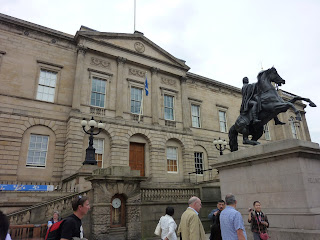
The Zoological Society of London Library tour was given by John Edwards, the Zoo historian. The building,built in 1910, currently houses the library, offices, and meeting rooms. To fully understand the library, Edwards first gave us background information about the London Zoo. The London Zoo opened in 1828 and in 1836, the Zoological Society was founded. In the 1850's, the Zoological Society's Museum collection was donated to the British Museum. At the end of the tour, we were shown pictures of some of the animals that were kept throughout the history of the London Zoo. We saw photos of the first hippo that came to the Zoo in 1850, a baby orangutan named Lady Jane, a sable antelope (the only one outside of Africa), the only photo of a living Quagga (a less striped Zebra), and photos of the first African Elephant, Jumbo, that came to the London Zoo. By 1912, there were a recorded 1 million visitors that came to the Zoo that year.
The Library was founded in 1826 and is now the largest privately owned zoological collection in the world. We spoke with Emma, the book cataloger, about her project that she has started. She is working on turning the card catalog to OPAC. So far, books published after 1993 and before 1860 have been cataloged to the OPAC. The card catalog was made in the 1960's. Ruth Jones spoke more about the collection. Their entire collection is housed in the same room. The library's collection holds conference proceedings, annual reports, zoo guides from all zoos, books about animals, animal breeding, husbandry material, and other zoo related material. Most of the items this library holds are hard to find items. Ann Sylph from archives showed us a few of the rare materials the library holds. We saw the ZSL's first charter, written by George IV in 1829. We saw letters by Darwin requesting help with specific bird names. We also saw the new charter, written by Elizabeth II in 1995. Popular inquiries made by patrons today are about family history. They are looking for past relatives who have worked in the London Zoo.





